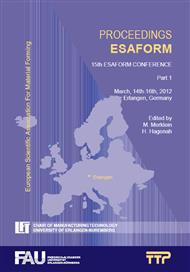p.3
p.17
p.23
p.29
p.35
p.41
p.47
p.53
p.59
Plastic Instability Based on Bifurcation Analysis: Effect of Hardening and Gurson Damage Parameters on Strain Localization
Abstract:
Strain localization, which occurs in metallic materials in the form of shear bands during forming processes, is one of the major causes of defective parts produced in the industry. Various instability criteria have been developed in the literature to predict the occurrence of these plastic instabilities. In this work, we propose to couple a GTN-type model [1,2], known for its widespread use to describe damage evolution in metallic materials, to the Rice’s [3] localization criterion. The implementation of the constitutive modeling is achieved via a user material (UMAT) subroutine in the commercial finite element code ABAQUS. Large deformations are taken into account within a three dimensional co-rotational framework. The effectiveness of the proposed coupling for the prediction of the formability of stretched metal sheets is shown and Forming Limit Diagrams (FLDs) are plotted for different materials. References [1] Gurson, A.L., Continuum theory of ductile rupture by void nucleation and growth: Part I- yield criteria and flow rules for porous ductile media. Journal of Engineering Materials and Technology, 99(1):2–15 (1977). [2] Needleman A., V. Tvergaard, An analysis of ductile rupture in notched bars, Journal of the Mechanics and Physics of Solids, 32, 461-490 (1984). [3] Rice, J. R., The localization of plastic deformation. Theoretical and applied mechanics. Koiter ed., 207-227 (1976).
Info:
Periodical:
Pages:
35-40
Citation:
Online since:
February 2012
Price:
Сopyright:
© 2012 Trans Tech Publications Ltd. All Rights Reserved
Share:
Citation:


